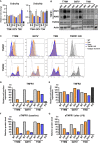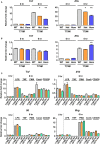TRAPS mutations in Tnfrsf1a decrease the responsiveness to TNFα via reduced cell surface expression of TNFR1
- PMID: 35936010
- PMCID: PMC9355097
- DOI: 10.3389/fimmu.2022.926175
TRAPS mutations in Tnfrsf1a decrease the responsiveness to TNFα via reduced cell surface expression of TNFR1
Abstract
Tumor necrosis factor (TNF) receptor-associated periodic syndrome (TRAPS) is an autoinflammatory periodic fever syndrome associated with heterozygous mutations in TNFRSF1A, which encodes TNF receptor type I (TNFR1). Although possible proinflammatory mechanisms have been proposed, most previous studies were performed using in vitro overexpression models, which could lead to undesirable inflammatory responses due to artificial overexpression. It is crucial to reproduce heterozygous mutations at physiological expression levels; however, such studies remain limited. In this study, we generated TRAPS mutant mice and analyzed their phenotypes. Three Tnfrsf1a mutant strains were generated by introducing T79M, G87V, or T90I mutation. T79M is a known mutation responsible for TRAPS, whereas G87V is a TRAPS mutation that we have reported, and T90I is a variant of unknown significance. Using these murine models, we investigated whether TRAPS mutations could affect the inflammatory responses in vivo and in vitro. We found that none of the mutant mice exhibited detectable inflammatory phenotypes under standard housing conditions for 1 year. Interestingly, TRAPS mutant (T79M and G87V) mice had reduced mortality rates after the administration of lipopolysaccharide (LPS) and D-galactosamine, which induce TNFα-dependent lethal hepatitis. Moreover, TRAPS mutations strongly suppressed the development of TNFα-mediated arthritis when crossed with human TNFα transgenic mice. In in vitro primary bone marrow-derived macrophage cultures, the T79M and G87V mutations attenuated the inflammatory responses to TNFα compared with the wild-type, whereas these mutations did not alter the responsiveness of these cells to LPS. The T90I mutant macrophages behaved similarly to wild type in response to LPS and TNFα. The TNFR1 levels were increased in whole-cell lysates of TRAPS mutant macrophages, whereas the cell surface expression of TNFR1 was significantly decreased in TRAPS mutant macrophages. Taken together, TRAPS mutations did not augment the inflammatory responses to TNFα and LPS; instead, they suppressed the response to TNFα via decreased cell surface expression of TNFR1. The stimulation of lymphotoxin-α, adenosine triphosphate, and norepinephrine in primary macrophages or various stimuli in murine splenocytes did not induce detectable inflammatory responses. In conclusion, TRAPS mutations suppressed responsiveness to TNFα, and TRAPS-associated inflammation is likely induced by unconfirmed disease-specific proinflammatory factors.
Keywords: TNF receptor 1; TNF receptor-associated periodic syndrome; autoinflammatory disease; murine model; tumor necrosis factor-α.
Copyright © 2022 Akagi, Hiramatsu-Asano, Ikeda, Hirano, Tsuji, Yahagi, Iseki, Matsuyama, Mak, Nakano, Ishihara, Morita and Mukai.
Conflict of interest statement
TA, SH-A, KN, and YM received scholarship donations from AbbVie, Asahi Kasei, Ayumi and Chugai. The remaining authors declare that the research was conducted in the absence of any commercial or financial relationships that could be construed as a potential conflict of interest.
Figures








Similar articles
-
Functional analysis of a novel G87V TNFRSF1A mutation in patients with TNF receptor-associated periodic syndrome.Clin Exp Immunol. 2019 Dec;198(3):416-429. doi: 10.1111/cei.13365. Epub 2019 Sep 4. Clin Exp Immunol. 2019. PMID: 31429073 Free PMC article.
-
Concerted action of wild-type and mutant TNF receptors enhances inflammation in TNF receptor 1-associated periodic fever syndrome.Proc Natl Acad Sci U S A. 2010 May 25;107(21):9801-6. doi: 10.1073/pnas.0914118107. Epub 2010 May 10. Proc Natl Acad Sci U S A. 2010. PMID: 20457915 Free PMC article.
-
Autophagy contributes to inflammation in patients with TNFR-associated periodic syndrome (TRAPS).Ann Rheum Dis. 2013 Jun;72(6):1044-52. doi: 10.1136/annrheumdis-2012-201952. Epub 2012 Oct 31. Ann Rheum Dis. 2013. PMID: 23117241
-
Revisiting TNF Receptor-Associated Periodic Syndrome (TRAPS): Current Perspectives.Int J Mol Sci. 2020 May 5;21(9):3263. doi: 10.3390/ijms21093263. Int J Mol Sci. 2020. PMID: 32380704 Free PMC article. Review.
-
Setting up TRAPS.Ann Med. 2012 Mar;44(2):109-18. doi: 10.3109/07853890.2010.548399. Epub 2011 Feb 1. Ann Med. 2012. PMID: 21284532 Review.
Cited by
-
A rare missense p.C125Y mutation in the TNFRSF1A gene identified in a Chinese family with tumor necrosis factor receptor-associated periodic fever syndrome.Front Genet. 2024 Jun 24;15:1413641. doi: 10.3389/fgene.2024.1413641. eCollection 2024. Front Genet. 2024. PMID: 38978873 Free PMC article.
-
Identification of TNFRSF1A as a potential biomarker for osteosarcoma.Cancer Biomark. 2024;39(4):299-312. doi: 10.3233/CBM-230086. Cancer Biomark. 2024. PMID: 38250759 Free PMC article.
-
A patient with tumor necrosis factor receptor-associated periodic syndrome misdiagnosed as Kawasaki disease: A case report and literature review.Heliyon. 2023 Sep 1;9(9):e19751. doi: 10.1016/j.heliyon.2023.e19751. eCollection 2023 Sep. Heliyon. 2023. PMID: 37810071 Free PMC article.
-
Co-occurrence of non-alcoholic steatohepatitis exacerbates psoriasis associated with decreased adiponectin expression in a murine model.Front Immunol. 2023 Aug 14;14:1214623. doi: 10.3389/fimmu.2023.1214623. eCollection 2023. Front Immunol. 2023. PMID: 37646025 Free PMC article.
References
-
- Lobito AA, Kimberley FC, Muppidi JR, Komarow H, Jackson AJ, Hull KM, et al. . Abnormal disulfide-linked oligomerization results in er retention and altered signaling by TNFR1 mutants in TNFR1-associated periodic fever syndrome (TRAPS). Blood (2006) 108(4):1320–7. doi: 10.1182/blood-2005-11-006783 - DOI - PMC - PubMed
Publication types
MeSH terms
Substances
Supplementary concepts
LinkOut - more resources
Full Text Sources
Molecular Biology Databases

